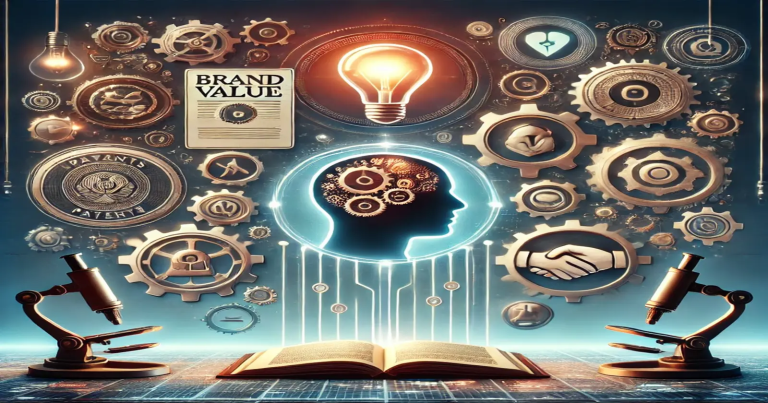Many people think assets only mean things like cash, land, or machines. But in today’s world, businesses earn a lot from things that you cannot see or touch. These are called intangible assets. In this article, we will explain in detail the types of intangible assets. We will talk about how they help a business, how they are used in accounting, and also give examples for each type.The term types of intangible assets means the different categories of non-physical assets that a business owns. These may include brand names, software, trademarks, patents, copyrights, and goodwill. These assets give companies an edge over others. They create value without having a shape or form.
What are Intangible Assets?
Intangible assets are assets that do not have a physical form but still help businesses grow. You cannot see them or touch them. But they still hold great value and help companies earn more money.Intangible assets are important because:
- They build customer trust and loyalty.
- They help in product design and innovation.
- They increase the total value of a business.
- They support branding and marketing efforts.
Companies protect these assets using legal rights like patents, trademarks, or copyrights. For example, Google’s search engine technology or the Apple logo are intangible assets. You cannot hold them in your hand, but they are worth billions.
In accounting, companies show intangible assets on the balance sheet. But they must follow accounting rules to report them. Some intangible assets can be bought, and some are developed by the business itself.
Types of Intangible Assets
Intangible assets are the non physical assets that have value but no physical existence. There are different types of intangible assets which are classified into different categories:
- on the basis of business segment
- on the basis of identifiability
- on the basis of acquisition
Types of Intangible Assets on the Basis of Business Segment
Classifying intangible assets based on business segments provides insights into the functional role these assets play within an organization. It groups intangibles by how they contribute to revenue generation, customer engagement, legal rights, brand building, or technological innovation. This operational lens allows businesses and investors to understand the strategic importance of various intangibles across departments—marketing, customer service, legal, and R&D.
1.Intangible Assets Related to Marketing:These allow companies to market their offerings and develop their brand image. They are an essential assets that shape consumer perceptions and build customer loyalty. Examples:
- Trademarks
- Brand names
- Logos
- Domain names
- Trade dress (such as product packaging)
McDonald’s golden arches, for instance, and the word “Nike” are trademarks. These are useful for customers to recognize the brand.
2. Customer-Related Intangible Assets: These assets relate to the company’s relationship with its customers.These are especially valuable in service-oriented and B2B industries where long-term customer engagement and recurring revenue are critical. Examples:
- Customer lists
- Order history
- Customer contracts
- Loyalty programs
A company that knows its customers well can sell better. E-commerce companies store this data and use it to send offers or improve services.
3. Technology-Based Intangible Assets: These come from research, development, or unique tech. Technology assets are a hallmark of innovation-driven industries such as pharmaceuticals, IT, and electronics. Examples:
- Patents
- Software
- Databases
- Trade secrets
Patents protect inventions. Software helps companies perform daily tasks. These assets give a competitive edge in tech-based industries.
4. Artistic and Contract-Based Intangible Assets:These involve creative works or legal agreements.Artistic intangible assets are created through artistic or literary effort and are typically protected by copyright laws.These assets arise from contractual agreements and legal rights that provide economic benefits to the entity.Examples:
- Copyrights
- Film and music rights
- Licensing agreements
- Franchise agreements
- Broadcast rights
Copyrights protect creative content like books or movies. Franchise rights allow others to sell under your brand name.
Types of Intangible Assets on the Basis of Identifiability
The classification of intangible assets based on identification centers around the asset’s separability and recognizability. This dimension helps in understanding whether an intangible asset can stand alone from the business and be traded independently or if it is inherently embedded within the business itself. This classification is crucial from an accounting and valuation perspective, as it determines how these assets are recognized on the balance sheet and how they are treated for impairment or amortization.
1. Identifiable Intangible Assets: Identifiable intangible assets are those that can be separated from the company and sold, licensed, rented, or exchanged, either individually or together with a related contract or identifiable asset. These assets are typically well-documented and can be precisely valued. Since they can be transferred or assigned to others, they hold intrinsic value independent of the business entity. Examples:
- Patents
- Trademarks
- Copyrights
- Customer lists
- Software
2. Unidentifiable Intangible Assets: Unidentifiable intangible assets are not separately distinguishable from the overall value of the business and cannot be sold independently. Example:
- Goodwill (arises from reputation, customer loyalty, brand value, etc.)
Types of Intangible Assets on the Basis of Acquisition
The classification for this type of intangible asset is based on acquisition—having an intangible asset either purchased from another entity or developed internally. This differentiation is an important one, as it will influence the accounting treatment of the instrument at initial recognition and at subsequent measurement.
1. Acquired Intangible Assets: Purchased intangible assets are those acquired from an external source and are usually recorded at their purchase cost, including any legal or registration fees directly attributable to the acquisition. These assets are easier to value since a transaction price exists.Examples:
- Purchased software
- Bought patents
- Brand rights acquired during mergers
These assets are easier to measure. Their price is known at the time of purchase. You add them to the balance sheet at cost.
2. Internally Generated Intangible Assets: Internally generated intangible assets are developed within the organization through innovation, research, and development, or brand-building activities. These include proprietary software developed in-house, unique processes, trade secrets, and even internally developed brand equity. While these can be immensely valuable, accounting standards like IAS 38 (or AS 26 in India) impose strict criteria for recognizing such assets due to challenges in reliably measuring their cost and future benefits.Examples:
- Brand image
- Customer relationships
- Product designs
Relevance to ACCA Syllabus
Types of intangible assets are covered in Financial Reporting (FR) and Strategic Business Reporting (SBR). ACCA expects students to understand how to identify, classify, and report intangible assets under IAS 38. These skills help in analyzing company valuations and preparing financial statements for entities with strong intellectual capital.
Types of Intangible Assets ACCA Questions
Q1: Which of the following is NOT classified as an intangible asset under IAS 38?
A) Patent
B) Goodwill acquired in a business combination
C) Internally generated brand
D) Registered trademark
Ans: C) Internally generated brand
Q2: According to IAS 38, how should research costs be treated?
A) Capitalized as an intangible asset
B) Deferred and amortized
C) Expensed as incurred
D) Shown under equity
Ans: C) Expensed as incurred
Q3: Which asset is amortized over its useful life?
A) Trademark with indefinite life
B) Acquired patent with 10-year life
C) Goodwill
D) Internally generated brand
Ans: B) Acquired patent with 10-year life
Q4: What is a common feature of all intangible assets under IAS 38?
A) They must be acquired from a third party
B) They are always amortized
C) They lack physical substance
D) They are shown under liabilities
Ans: C) They lack physical substance
Relevance to US CMA Syllabus
In the CMA syllabus, the classification and recognition of intangible assets impact performance evaluation, asset management, and decision-making in cost accounting. CMAs must evaluate the future economic benefits of assets like software, patents, and brand names.
Types of Intangible Assets US CMA Questions
Q1: Which of the following best describes a customer list?
A) Physical asset
B) Tangible property
C) Intangible asset
D) Current liability
Ans: C) Intangible asset
Q2: A trademark is an example of which type of intangible asset?
A) Marketing-related
B) Financial-related
C) Liability-related
D) Service-based
Ans: A) Marketing-related
Q3: Which of the following is a technology-based intangible asset?
A) Franchise agreement
B) Copyright
C) Trademark
D) Software
Ans: D) Software
Q4: Why are intangible assets important in performance management?
A) They reduce payroll costs
B) They increase inventory turnover
C) They enhance business valuation
D) They reduce fixed costs
Ans: C) They enhance business valuation
Relevance to US CPA Syllabus
For CPA candidates, the FAR (Financial Accounting and Reporting) section includes classification, measurement, and amortization of intangible assets under ASC 350 and ASC 805. Understanding types of intangible assets is essential in business combinations, impairment testing, and financial disclosures.
Types of Intangible Assets US CPA Questions
Q1: Which of the following intangible assets is NOT amortized?
A) A copyright with a 20-year term
B) A software license for 5 years
C) A brand with indefinite life
D) A customer list with 3-year benefit
Ans: C) A brand with indefinite life
Q2: Under US GAAP, goodwill is:
A) Amortized over 10 years
B) Recorded only during acquisitions
C) Written off as an expense
D) Never tested for impairment
Ans: B) Recorded only during acquisitions
Q3: What is the correct classification of broadcast rights?
A) Customer-related intangible asset
B) Artistic-related intangible asset
C) Marketing-related asset
D) Inventory
Ans: B) Artistic-related intangible asset
Q4: Which of the following is considered an internally generated intangible asset?
A) Purchased software
B) Customer list from an acquisition
C) Developed brand reputation
D) Franchise rights
Ans: C) Developed brand reputation
Relevance to CFA Curriculum
The CFA Program covers intangible assets under Financial Statement Analysis. Analysts must understand asset classification, amortization rules, and the impact on equity and valuation ratios. It’s especially important in company valuation models and equity research.
Types of Intangible Assets CFA Questions
Q1: Which of the following is NOT a component of intangible assets per IFRS?
A) Software
B) Trademark
C) Plant and machinery
D) Copyright
Ans: C) Plant and machinery
Q2: Which type of intangible asset affects brand loyalty and consumer perception?
A) Trademark
B) Patent
C) Inventory
D) Deferred tax
Ans: A) Trademark
Q3: How are customer lists generally classified?
A) Contract-based intangible assets
B) Customer-related intangible assets
C) Marketing-related intangible assets
D) Deferred expenses
Ans: B) Customer-related intangible assets
Q4: A company creates a logo that brings future value. Under IFRS, how is it treated?
A) Recorded as inventory
B) Shown under liabilities
C) Expensed if internally generated
D) Capitalized always
Ans: C) Expensed if internally generated


